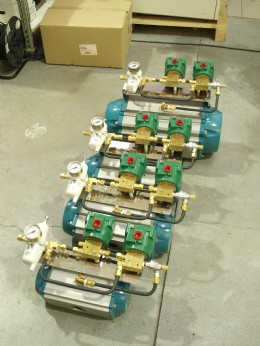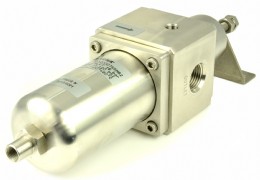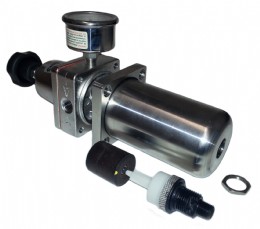Manual or Auto Drain Airsets – does it matter?

Solenoid valve with strainer and cyclic timer

Manual drain filter regulators fitted to actuator assemblies

Autodrain filter reg

Autodrain and bowl disassembled
Filter regulators are commonly used to provide local pressure regulation and air filtration prior to the positioners and pilot valves that control pneumatic actuators. The action of the air movement through the filter bowl allows the water vapour to condense in the bowl but if the level of condensate is allowed to rise and fill the bowl, the water will get re-entrained in the downstream air. Efficient draining of the condensate is therefore very important for reliable valve and plant operation.
The method of releasing accumulated condensate from pneumatic filters and filter regulators probably isn’t the major consideration for most when deciding on an airset specification for an actuated valve, but understanding the choices available is essential to ensure that plant operations are not compromised.
Manual Drain
This is the simplest common drain system and can be in the form of a screwed plug, sprung button, needle or ball valve at the bottom of the bowl that requires an operator to regularly release the condensate and depending on the plant (and their safety regs or lack of), this can be into a catch tank, surface drain or just on to the floor to evaporate back into the atmosphere.
The timing of the draining can be matched to the plant operation by the operator such that when the system is not under pressure, the condensate evacuates solely under the effect of gravity and therefore plant air pressure (energy) is not wasted to atmosphere for the period of the valve being open. If the system is under pressure, the water will be forced out adding a constant load to the supply air pressure until the valve shuts, potentially wasting a large volume of air. There are also several operator health & safety issues with this if the drain port is not piped to a remote location.
To save time, operators sometimes leave drain valves just cracked for constant bleeding (wasting huge volumes of air) but risk them closing over time due to the build-up of limescale or debris. This could have very serious consequences for plant reliability, safety and production.
Capture of the condensate can allow the operator to monitor the air system health either visually or through chemical analysis which can assist planned maintenance schemes or quickly highlight immediate remedial action being necessary.
For areas where the bowl can fill quickly and need emptying often during the working day, an automatic drain may prove more efficient although this insight would be useful to identify and remedy the cause of the water build up in the first place.
Automatic Drain
This method employs a sprung valve and float to open on rising water level or removal of inlet pressure. At first glance this would seem the obvious choice for all installations as it removes the need for operator intervention but for low pressure systems the valve can leak and waste air as they commonly need around 1Bar constant pressure to seal so in this case a filter supplying 10psi would be better with a manual drain. The float mechanism will often be manufactured in plastic which will limit the maximum inlet pressure of the filter regulator to 16Bar or less depending on the make and model.
Removing the need for an operator saves time costs but also prevents the possibility of assessing operation as the float mechanism could fail closed leading to increasing condensate retention until something more expensive breaks downstream such as a smart positioner. A more common fault would be for the valve to fail open and thus be constantly venting air to atmosphere, significantly increasing the air plant operating costs. For this reason we would recommend that all autodrain filters and filter regs are regularly inspected and tested for correct operation.
Timed Drain
Where there is a need for non-operator controlled condensate draining but the system pressure is very low and an autodrain can’t be employed, the simplest and most cost effective way of achieving this is with a manual drain bowl coupled via a strainer to a small solenoid valve operated by a cyclic timer. This method is often seen on air reservoirs and with a very short On time, minimal wastage of air occurs while the water is released at regular intervals 24/7.
Which to Choose?
The age and scale of the plant, air quality at proposed point of use, maintenance regimes in place, system health, operator time, climatic conditions and consequences of failure are all prime considerations in selecting and specifying these products to achieve optimum reliability and lowest cost of operation for the systems to which they are fitted.
The lower cost manual drain version depends on regular and expensive user involvement throughout operations but also offers the opportunity for rapid identification of issues in air quality and components to maximise plant efficiency. The more expensive autodrain version is great for remote installations but is not ‘fit and forget’ as it will still need periodic inspection and maintenance. It is not suited to low (<1Bar) or high (>16Bar) pressure systems.
The manual drain with timer controlled solenoid can be an excellent compromise where electrical supplies are permitted and can be combined with a ball valve for manual checking of the condensate or maintenance bypass of the solenoid valve. It does waste small amounts of air on each operation and will need regular inspection and maintenance.
Filter regs are often seen as non-critical commodity type products and as such their importance to plant operation is frequently not fully appreciated. As in any system, the weakest link will give the most problems and the specification of a quality airset with the correct drain method to suit the maintenance scheme of the plant could offer considerable long term savings.
Red Dragon Valves
Tel: 01443 772500
www.reddragonvalves.co.uk
Published: 13th May 2014
Rachel Wormald, Managing Director at YPS Valves Ltd and Elizabeth Waterman, ...
Are you looking for industry-leading, brand independent valve and actuator ...
As can be seen from the photograph, clearly the resident birds at Bartlett ...
Howco Group has unveiled its latest £1million investment, with the ...
In 2024, Allvalves is poised for an exciting year of growth and expansion, ...
GMM Pfaudler Engineered Plastics & Gaskets are delighted to bring the ...
In the ever-evolving valve industry, GMM Pfaudler stands out for its ...
SAMSON Controls Ltd – part of the SAMSON group - a renowned leader in ...










